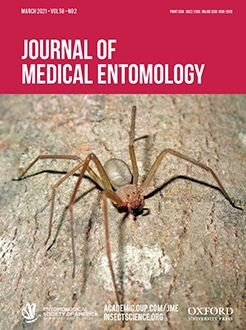The toxic effects of an avermectin-impregnated fine plant powder (AIFP) against larval Aedes aegypti L. (Diptera: Culicidae), Culex modestus Ficalbi (Diptera: Culicidae), and Anopheles messeae Falleroni (Diptera: Culicidae), as well as selected nontarget aquatic invertebrates, were studied under laboratory conditions. The possibility of trophic transfer of avermectins (AVMs) through the food chain and their toxic effects on predaceous species fed AIFP-treated mosquito larvae was also evaluated. Among mosquitoes, Anopheles messeae were the most sensitive to AIFP, while Cx. modestus exhibited the least sensitivity to this formulation. Among nontarget aquatic invertebrates, the greatest toxicity of AIFP was observed for benthic species (larval Chironomus sp. Meigen (Diptera: Chironomidae), whereas predators (dragonflies, water beetles, and water bugs) exhibited the lowest AIFP sensitivity. AIFP sensitivity of the clam shrimp Lynceus brachyurus O. F. Muller (Diplostraca: Lynceidae), the phantom midge Chaoborus crystallinus De Geer (Diptera: Chaoboridae), and the mayfly Caenis robusta Eaton (Ephemeroptera: Caenidae) was intermediate and similar to the sensitivity of the mosquito Cx. modestus. However, these nontarget species were more resistant than An. messeae and Ae. aegypti. Solid-phase extraction of mosquito larvae treated with AIFP and subsequent high-performance liquid chromatography (HPLC) analysis of the extracts revealed an AVM concentration of up to 2.1 ± 0.3 µg/g. Feeding the creeping water bug Ilyocoris cimicoides L. (Hemiptera: Naucoridae) on the AIFP-treated mosquito larvae resulted in 51% mortality of the predaceous species. But no toxicity was observed for Aeshna mixta Latreille (Odonata: Aeshnidae) dragonfly larvae fed those mosquito larvae. The results of this work showed that this AVM formulation can be effective against mosquito larvae.
How to translate text using browser tools
28 October 2020
Toxic Effects of Fine Plant Powder Impregnated With Avermectins on Mosquito Larvae and Nontarget Aquatic Invertebrates
Olga Belevich,
Yury Yurchenko,
Alexander Alekseev,
Oxana Kotina,
Vyacheslav Odeyanko,
Yury Tsentalovich,
Lyudmila Yanshole,
Vadim Kryukov,
Victor Danilov,
Victor Glupov
ACCESS THE FULL ARTICLE
It is not available for individual sale.
This article is only available to subscribers.
It is not available for individual sale.
It is not available for individual sale.

Journal of Medical Entomology
Vol. 58 • No. 2
March 2021
Vol. 58 • No. 2
March 2021
aquatic invertebrate
avermectins
fine plant powder
mosquito larvae
toxicity




